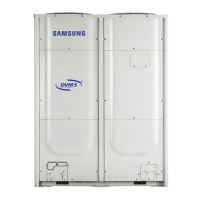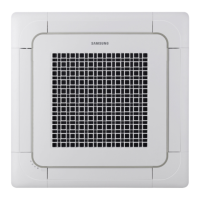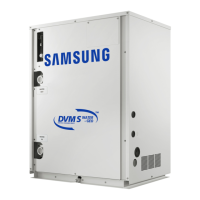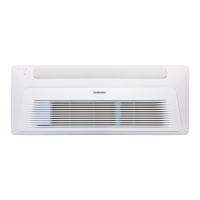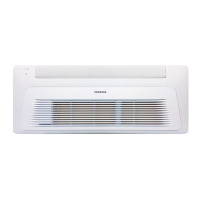
Do you have a question about the Samsung AM JXVAF Series and is the answer not in the manual?
| Brand | Samsung |
|---|---|
| Model | AM JXVAF Series |
| Category | Air Conditioner |
| Language | English |
Follow safety info for installer/user on R-410A refrigerant, pressure limits, and proper user explanation.
Warnings on unqualified installation, refrigerant leaks, component use, and outdoor unit placement.
Safety rules for welding, product modification, electrical work, grounding, wiring, and power cutoff.
Cautions for drain pipe, cable installation, outdoor unit placement, and proximity to lighting/waves.
Conditions for selecting installation location considering noise, structure, wind, ventilation, and piping.
Guidelines for constructing the base ground, including height, leveling, drainage, and reinforcement.
Guidelines for refrigerant pipe length, height difference, pressure, and material compatibility for R-410A.
Importance and procedure of nitrogen flushing during welding to prevent pipe damage from oxides.
Proper procedure for connecting flared pipes, including torque specifications and using ester oil.
Safety measures during pipe welding, protecting the unit from heat, flame, and sensors.
Specifications for circuit breakers (MCA, MFA) and power cables for different outdoor unit models.
Essential cautions for electrical work, including installing ELCB/MCCB, cable handling, and using appropriate power cables.
Shows the power wiring configuration for 3-phase units and connection of indoor/outdoor communication cables.
How to connect cables to the terminal board using solderless ring terminals, including torque and cable management.
Grounding must be done by a qualified installer for safety; guidelines for power cable grounding based on voltage and humidity.
Procedure for performing air tightness test using Nitrogen gas, checking for pressure drops and leaks.
Steps for vacuum drying refrigerant pipes, checking for gas leakage, and handling moisture.
Procedure for adding liquid refrigerant for single installation using manifold gauge and service valves.
Procedure for adding refrigerant for module installation, including using PCB functions and manifold gauges.
How to enter option setting mode, adjust values using switches, and save settings.
Using K4 to display various operational parameters like unit model, pressures, temperatures, and EEV steps.
Measures to take before supplying power, including insulation resistance and voltage/phase checks.
Checklists for installation work, refrigerant pipe work, drain pipe work, electrical wiring, and settings.
Important precautions before starting test operation, including power supply timing and handling hot/cold pipes.
Steps to perform before auto trial operation, including cable checks, power supply, voltage testing, and setting addresses.
Steps for conducting auto trial operation, checking for errors, and verifying normal cooling/heating performance.
Steps to resolve E503 errors, focusing on service valve, 4-way valve, EEV, and refrigerant quantity.
Measures to take when E505 or E506 errors occur, involving vacuum mode, pressure sensors, and trial operation.
Steps to perform automatic refrigerant amount detection using tact switches or S-CHECKER.
Actions to take based on detection results like excessive/insufficient refrigerant or supercooling.
